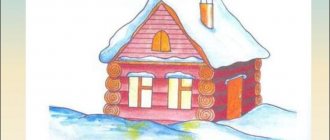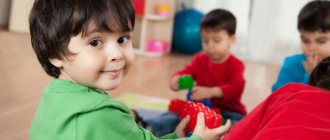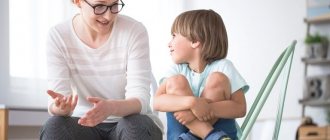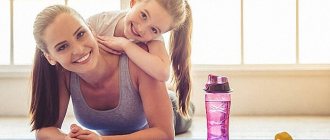Parents often wonder: how to teach a child to read and when should you start doing this? Experts recommend not to delay this issue. Of course, there is no point in showing your baby cards with letters, but he can and should read them.
To download a sheet with a story, right-click on it. In the window that opens, select “Save image as.” Save to your PC desktop and print.
We teach children to tell stories based on pictures.
Dear friends! If you decide to work with your child according to the recommendations of the “Native Path” website, it means that you want him to grow up healthy, strong, independent, cheerful, and smart. I will be happy to help you with this and share my experience of teaching preschoolers their native language. Lessons using pictures from this article will teach a child to speak accurately and expressively, compose funny and instructive stories and riddles, reason, compare, establish the cause and effect of events, draw conclusions, and distinguish the sounds of their native language.
This article includes my own experience of conducting games and activities with children based on my own book “Appchhi, be healthy!”, published by the publishing house “Karapuz”. In this article, I tried to talk about how to make book lessons more interesting and entertaining for children, and I added and clarified the recommendations for conducting them. What you will find below is a version of games and activities that has been tested with dozens of children from 4 to 6 years old. This option of classes was specially selected by me from many others as the most effective and most interesting for children and adults, joyful and cheerful!
Development of a child’s coherent speech - download tasks
The development of coherent speech is the main, advanced point in the development of communicative abilities and maturation.
Through the speech apparatus, the child learns to communicate. A vocabulary and the ability to convey feelings and thoughts become the key to comfortable learning and perception of the world. Poor development of coherent speech in preschoolers often causes hysterics and worries parents. The childdevelop website presents exercises for the development of coherent speech, developed by experienced teachers, psychologists and speech therapists. The author's methods and visual exercises for the development of coherent speech will be beneficial and useful.
How to work with your child on speech development: useful tips from my experience of games and activities using a book.
Games and exercises for children's speech development with story-based pictures.
In the article and in the book you will find six series of plot pictures
. Read the text of the assignments in advance and prepare the necessary material.
To complete some tasks, you will need to cut out rectangles from cardboard to the size of the pictures to cover the images. This is done so that the child tries to guess what will happen next or, conversely, to identify the cause of events. This way your baby will learn to establish cause-and-effect relationships, reason, draw conclusions, and prove his point of view. It is very important that the child himself tries to find answers to questions and makes assumptions. Don't be too quick to give the "correct" answer. The baby needs to make a small discovery himself and experience the joy of it.
mistakes
in answering questions , for example, says “prettier” or “brighter,” then do not scold him, do not laugh at the mistake, but tactfully correct him: “Think about how to say it correctly... Yes, you guessed it. We must say “brighter”.
Writing fairy tales from pictures
will help children learn to tell stories in a certain sequence, in accordance with the structure of the story (beginning, middle, end), use figurative expressive means of language, and will contribute to the development of the child’s imagination and creativity.
If it is difficult for a child to compose a fairy tale on his own, then help him. Say the beginning of phrases, and the baby will continue them himself. Look how this was done in the tasks for the pictures “Teddy Bear.” You can help your child by giving him a plan. If there is a long pause during the story, help the child with questions: “What happened to the pig next?” or “Where did the puppy go? Who did he meet?
Game “Guess which word is lost”
? Intended for children five years and older. This fun exercise in an entertaining way will teach your baby to hear and isolate the sounds of his native language from the flow of speech, that is, it will contribute to the development of phonemic hearing. If it is difficult for a child to find the right word, then highlight the wrong word in a couplet and offer to replace it. When selecting rhymes, encourage the child’s independence, do not rush to say the correct answer. Help him with a hint, for example, “Flour-...What is this? (point to the child’s hand).” “Hand!”, the baby will guess. Rejoice at his discovery and repeat these couple of words with him. If a sound in a task needs to be highlighted with a voice, then it is indicated in the text by several letters (“essskimo”, “gradussnik”).
When discussing proverbs with children
It is very important to help the child understand their meaning using specific examples from his life experience, fairy tales, and stories. Think about similar situations your child has been in or observed and talk about them.
not look at several series of pictures at one time with your child.
This leads to overtired children, reducing their interest in classes and their effectiveness. It is enough to talk about one episode and do additional tasks for it, given below. To complete additional tasks you will need toys, pencils or paints, and drawing paper. Prepare them in advance.
After looking at all the series of pictures
ask your child why they say this: “Health is more valuable than gold,” “Take care of your health from a young age.” Invite him to tell you how he takes care of his health, and write a letter to Aibolit about it. The child will dictate, and you will write down his story. Prompt your child to start phrases, and he will continue them. Ask your child to draw pictures for his story for Aibolit.
Additionally, you can conduct games and exercises with your child with subject pictures on the topic “Health”.
Name with your child or find in the pictures:
a) items necessary for the doctor and nurse to work;
b) objects that help us always be clean and tidy;
c) healthy foods.
Ask your child which of these items he has at home and why they are needed. Play the game "Guess the object"
».
Option 1. You describe the object, and the child guesses it. For example: “The doctor needs this item. It is glass, long, it helps to find out whether a person is sick, what his temperature is.” After several riddles, invite your child to tell you a similar riddle himself.
Option 2. The child makes a wish for one object. You try to guess what it is by asking questions. For example: “Is this item a product?” (No). “Does a doctor need this item to treat people?” (Yes). “Is he needed to give injections?” (Yes). "It's a syringe." (Yes). After a while, invite the child to switch roles.
Invite your child to pack his doctor's case. To do this, you need to draw all the objects that he will need for work and explain why he needs them.
I wish you the joy of communicating with your baby and interesting activities and games with him!
You will find a link to download pictures at the end of the article.
A series of pictures for storytelling 1. Teddy bear with a sweet tooth.
Who is in the picture? Call the little bear affectionately ( bear, little bear, little bear, little bear
).
What is the bear doing? What is he like? ( Clubfooted, happy, funny, amusing, cheerful, furry, joyful
).
Look at the second picture. What happened to the bear? How did you guess? Why does the bear have a toothache? Look at the third picture. Who did the bear come to? What does Aibolit do? Why do you need to brush your teeth every day?
Let's tell a fairy tale about this bear cub together: “Once upon a time... He loved to eat very much... One day Mishutka... There was a lot of honey... Teddy Bear... The next day he had... Mishka wandered to... Aibolit taught him... Now Mishutka...”. What can we call our fairy tale? It should be clear from the title what it says.
Honey is sweet. What else could be sweet? Guess my riddle: “Sweet, beautiful – is this a cake or candy?”, “Sweet, fragrant, tasty – is this honey or jam?”, Sweet, chocolate – is this candy or cake? What do you call a person who eats a lot of sweets? ( Gourmand, sweet tooth
).
Which word got lost?
The bear ate a lot of honey. The bear's oak tree is sick. ( Oak-tooth
). Say these lines correctly.
Now let's play rhymes. Replace the first sound in words with the sound z and you will guess the rhyme. For example, oak is a tooth. Try. It's fun and interesting. Mike - ... ( bunny)
, door - ... (
beast
), gave - ... (
hall
), carriage - ... (
pen
), set - ... (
fence
).
Complete the sentences. “We need teeth so that... If there is a lot of sweets, then... Mishutka’s teeth hurt because... I brush my teeth every day so that...”.
Additional task. What should you do to keep your teeth healthy and pain-free? ( Don’t eat a lot of sweets, brush your teeth with toothpaste every day, have your teeth treated by a doctor on time, eat healthy foods: fruits, vegetables, cottage cheese...).
Come up with signs that will help you remember Dr. Aibolit’s advice and draw them. Draw a no sign (for example, crossed out sugar and candy) and an allow sign (for example, a toothbrush and a clock or calendar).
A series of pictures for storytelling 2. How Piggy the pig learned to be neat.
Close the first picture and start looking at the second illustration . How is the piglet feeling? How did you know this? The piglet is crying. How can you say it differently? He...( cries, sheds tears, roars
).
What do you think happened to him? Why is he crying? Let's see if we guessed right or not (open the first picture). What is Piggy doing? What pig? ( Unwashed, sloppy, dirty, unkempt
). Where is he sitting? Have you already guessed why he got sick?
Look at the next picture (third). Who did Piggy come to? What does Aibolit do? Why did he take soap, a brush and a basin of water? Why does he need a towel? Now you will be Aibolit. Tell Piggy what needs to be done so that such troubles don’t happen to him again.
Come up with a fairy tale about how Aibolit taught Khryusha to be neat.
Guess which word is lost.
The pig was dirty. The doctor dug it with soap. ( Soap-snout
). Say these lines correctly.
It's time for a rhyming game. Replace the first sound in words with the sound r and you will guess the rhyme. Soap - ...( dug
), varnish - ... (
crayfish
), mother - ... (
frame
), salt - ... (
role
), cat - ... (
mouth
), flour - ... (
hand
), trunk - ... (robot).
Additional task: Why can’t you eat with dirty hands? Is it possible to eat and at the same time play with sand, with boats in a puddle, with pets? Why? When should you wash your hands? ( After using the toilet, walking, before eating
...). Why do we wash our hands with soap?
What else do you need to do to be clean and tidy? Why do they say: “Sun, air and water are our best friends”? How does water help us be healthy? ( We wash our hands, wash ourselves, bathe, swim, wash clothes, wipe off the dust with a damp cloth, harden ourselves
…).
What would happen if the water disappeared? How do you keep things clean? Draw a picture about helping water. How do fresh air and sun help us be healthy? Why is it useful to walk in the forest or park? Why do you need to ventilate the room?
A series of pictures for storytelling 3. How the puppy learned to get acquainted.
Look at the first picture. What happened on the lawn? What is the chicken's mood? How did you guess? The puppy wanted to meet the chicken, and the chicken got angry with him. How do you think why? What did the puppy do wrong?
Look at the second picture. What happened to the puppy? Why did his nose hurt? Why does the doctor lubricate the wound with iodine? Say in one exhale: “Oh-oh-oh, oh-oh-oh, my nose hurts!” (development of speech breathing). What does a puppy need to remember so that this doesn’t happen to him next time?
Does the chick look like its mother? How are they similar? What is the difference? I'll start, and you finish. The hen has a large beak, and the chicken has a small...( beak
).
The mother has big wings, but the chick has small ones...( wings
).
The hen has long feathers, and the chick has short...( feathers
).
The chicken has a big head, and the chicken has a small...( head)
.
The chicken has a big tail, and the chicken has...( tail
).
Make up a story about how a puppy wanted to meet a chicken and what came of it. What will you call her? It should be clear from the title what your story is about.
Find which word is lost:
Rook anointed his nose with iodine so that the dog could run healthy. ( Rook Doctor
).
Repeat these lines correctly.
Additional task: Do you know how to meet people? What words are you saying? ( Hello. Let's get to know each other. My name is... What's your name? How old are you? What do you like to do? Let's play together
...). Play out an acquaintance scene with toys
A series of pictures for storytelling 4. Bouncing bunny.
Close the second picture. Look at the first illustration. Who is in the picture? Call the little bunny affectionately. ( Bunny, bunny, bunny, bunny, bunny
).
What bunny? ( Cheerful, fluffy, nimble, dexterous, agile
).
The bunny has long ears. How can you say about him? He...( long-eared
).
He has a short tail. Bunny...( short-tailed
).
The hare has big eyes. He...( big-eyed
).
Look at the third picture (the second is still closed). What happened to the bunny? How did you figure this out? Why does Aibolit bandage his paw? Think about what happened to the bunny, how he injured his paw.
Let's see if you guessed right (open the second picture). What happened to the bunny? Why did this happen to him?
Let's come up with a riddle about a bunny. "He's gray like...( mouse
).
He is fluffy like...( cotton wool
).
He is as nimble as... ( a sparrow
). Who is this?". Tell this riddle to your friends.
What do the proverbs “Look before you leap”, “Look at your feet: you won’t find anything, at least you won’t hurt your legs” teach us?
Which word got lost?
The bunny jumped merrily. It's a pity that I broke my hat. (Hat-paw). Say it right.
Let's play rhymes. Replace the first sound in words with the sound l, and you will find a rhyme. Cat -…( spoon
), beetle -...(
bow
), lady -...(
llama
), poppy -...(
crayfish
), helmet -...(
mask
). What sound was hidden from you in the words lllapa, skakallka, sllomall, jumpalll, zabinowall? Think of other words with the sound l.
Additional task: The bunny loves to jump. What outdoor games and exercises do you like? Are they good for health? Do you know why you need to do exercises in the morning? (It drives away sleep, gives cheerfulness, joy, improves health, teaches you to move correctly and beautifully
).
What sports games do you know? What is an athlete who plays football called? ( Football player
).
Hockey? (Hockey player
).
Volleyball? ( Volleyball player
).
Basketball? (Basketball player
).
Tennis? ( Tennis player
).
Swimming? ( Swimmer
).
Skis? ( Skier).
Jumping?
( Jumper
).
A series of pictures for storytelling 5. About sweet ice cream and bitter medicine.
Look at the first picture with your child (the second and third should be closed). What is the squirrel doing? How many servings of ice cream has she already eaten? How do you know? What is the squirrel's mood? ( Cheerful, joyful, cheerful
). Why is she so happy? What could happen to the squirrel next? Why do you think so?
Make up a story about what happened to the squirrel.
Now let's open the second picture. How is the squirrel feeling? What's her mood? Why did she tie the scarf around her throat? Why is she holding a thermometer? What do you think Aibolit will need to cure her? What advice will he give her?
Let's open the third picture. What does Aibolit do? The squirrel drank a spoonful of the mixture and wrinkled its face. What was the mixture? What else could be bitter? When the squirrel ate ice cream, it smiled. What kind of ice cream was it? What's healthier - ice cream or an apple? Candy or carrot? Juice or Fanta? Why?
Which word got lost?
The baby squirrel got sick. She drinks cat medicine. (Spoon cat). Repeat these lines correctly.
Guess what sound occurs in all the words I speak. I ate it, essskimo, thermometer. (Sound c). Clap your hands if you hear the s sound in the word. Mixture, tablet, medicine, glass, scarf, spoon, tail, throat, bag.
Additional tasks. Talk to your child about healthy foods. Offer to play grocery store. Let your child draw a window display for this store. Ask your child why he drew these particular products and why they are useful. Ask which ones he will buy in the store. Together with your child, think about what dishes can be prepared from his products. Create your own book of favorite and healthy dishes. The kid will draw pictures in it, and you will write captions for them.
How to read stories with pictures correctly
An adult and a child take part in the reading. The adult reads the lettered part of the story and pauses when an image appears in the text. The child names what he sees in the picture.
Having reached the end of the text, the adult asks the question: “What was the story about?”, “What were the names of ... (the characters).” Answering these questions, the little person does a lot of brain work. He uses his memory to try to remember the text. Carefulness and logic, looking at the pictures, recreates the order of actions in the story. In the future, this knowledge will be consolidated in the subconscious, and it will be easier for the child to write summaries at school. He will learn to isolate certain points and, based on them, reproduce the entire text in memory.
Texts with pictures instead of some words are different:
- black and white;
- colorful;
- with stickers.
Their use largely depends on the age and level of development of the baby. For example, to make the baby more interesting, you can offer him to color black and white pictures. This will allow the little man to better remember the fairy tale and then tell it in his own words.
By the way, you should not use such manuals in electronic form. Young children get tired quickly when working with static pictures on a computer monitor or tablet screen. This means that such exercises will be ineffective.
So, if it is not possible to purchase fairy tales and stories with pictures instead of certain words, then it is better to download and print them. During the lessons, these leaves can be collected into a book, and then together with the child, make a cover for which he will come up with and draw some kind of picture.





